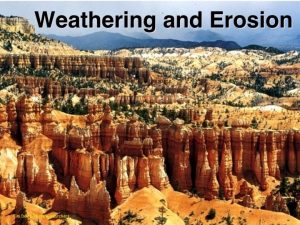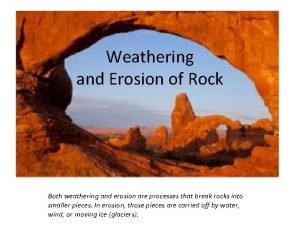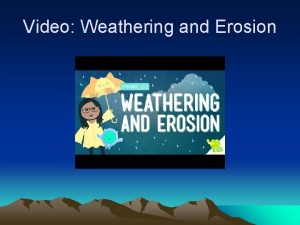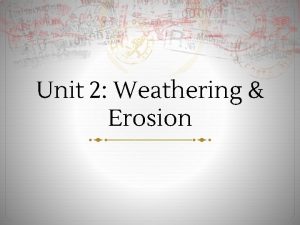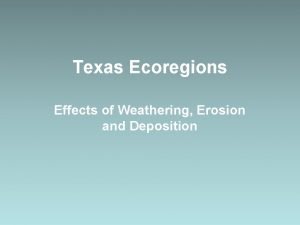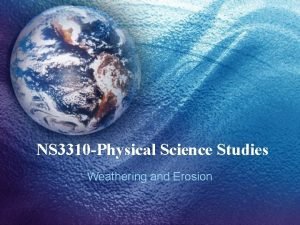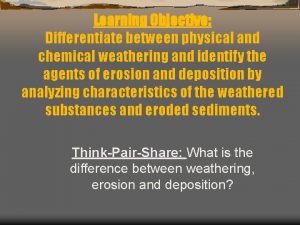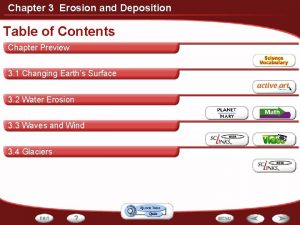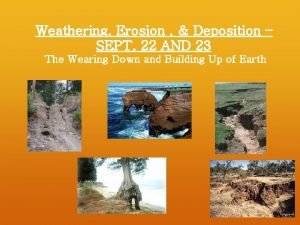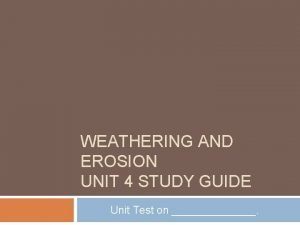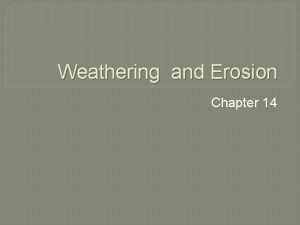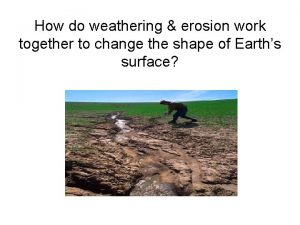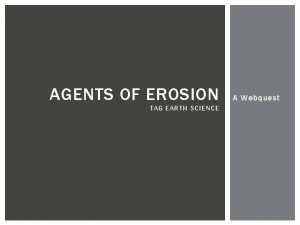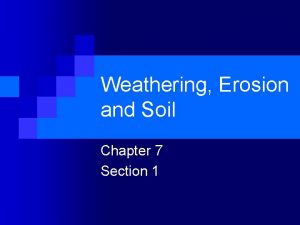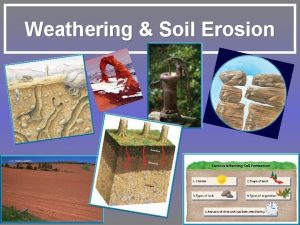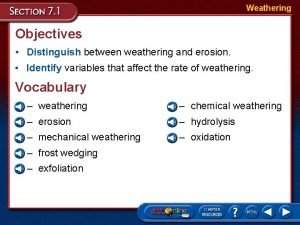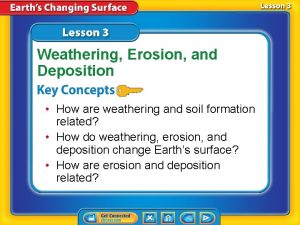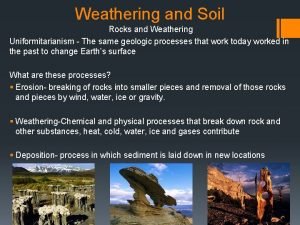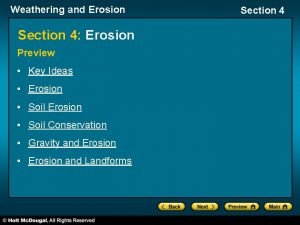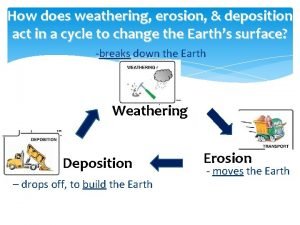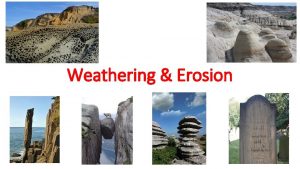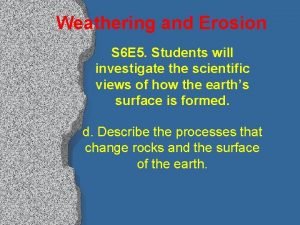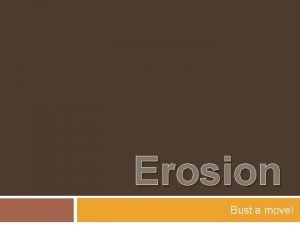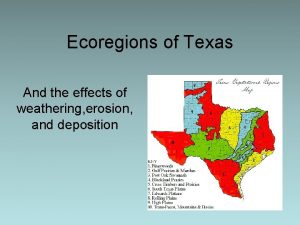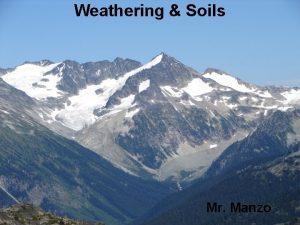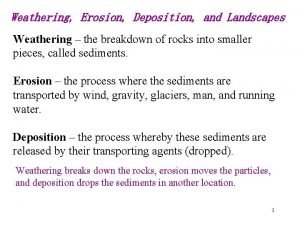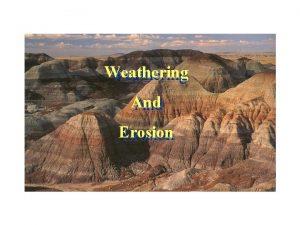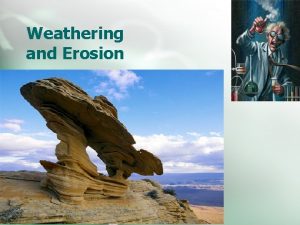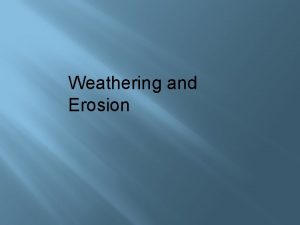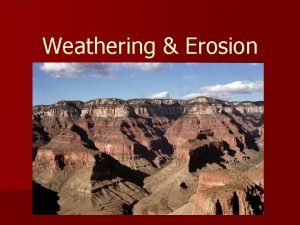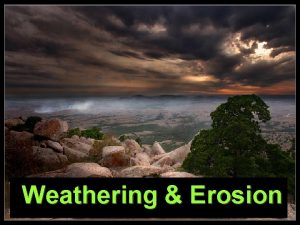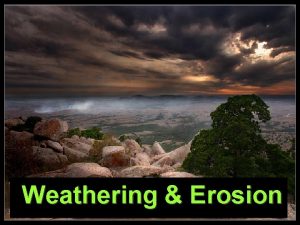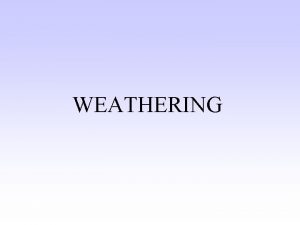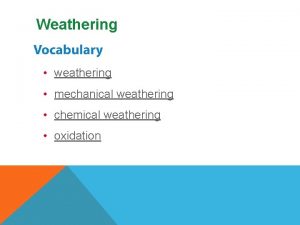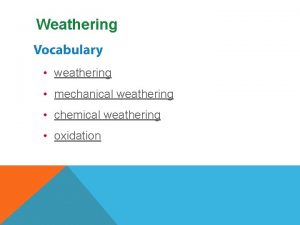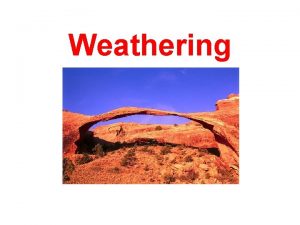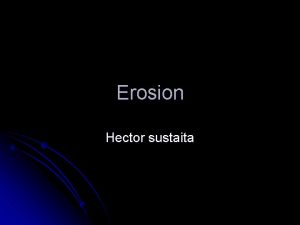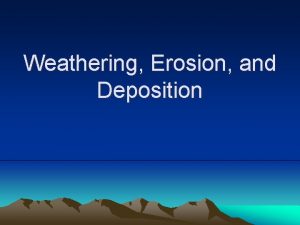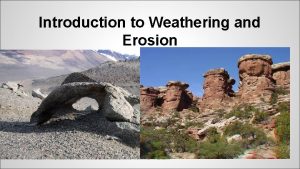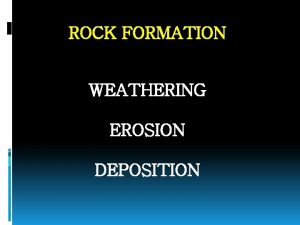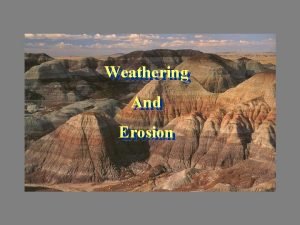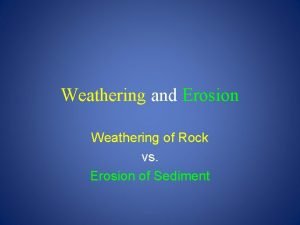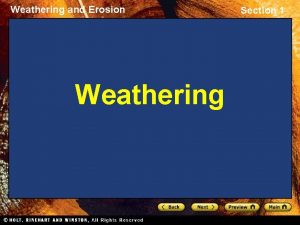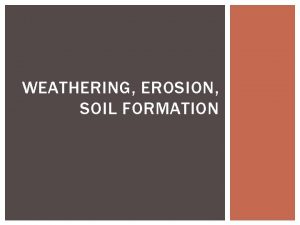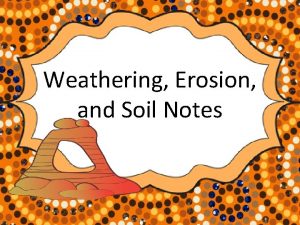Weathering and Erosion Mr Scichilone Weathering Weathering is
































- Slides: 32

Weathering and Erosion Mr. Scichilone

Weathering • Weathering is simply the chemical and/or physical breakdown of a rock material-weathering involves specific processes acting on rock materials at or near the surface of the Earth

Types of Weathering • Physical Weathering( mechanical) – Takes place when rock is split or broken into smaller pieces of the same material without changing its composition. Example: Breaking of a rock cliff into boulders and pebbles

Physical Weathering • Process by which rocks are broken down into smaller pieces by external conditions. • Types of Physical weathering – Frost heaving and Frost wedging – Plant roots – Friction and impact – Burrowing of animals – Temperature changes

Frost Wedging

Plant Roots

Temperature Changes

3. Temperature Changes 1. Objects expand contracted when heated and cooled 2. When rocks are heated and cooled cracks are created. 3. Overtime rocks are weathered · Agent: Temperature · Climate: Hot and Arid (dry)

4. Abrasion ·When rocks grind against other rocks. ·Over time they get smaller · Agents: ice, gravity, water, air · Climate: All Climates

• Plant Action—growing roots weaken the rocks. Water pressure in the roots cracks rocks • Animal Activity—holes and burrows dug by animals lets air and water into the ground • Abrasion—”sand blasting” of rock by wind or water.

Types of Mechanical Weathering • Action of plants and animals: – Lichens and mosses grow on rocks • They wedge their tiny roots into spores and crevices. • When the roots grow, the rock splits.

Types of Mechanical Weathering

Types of Mechanical Weathering • Frost Action—freezing of water in a joint, the water/ice expands widening the joint. The ice melts and water seeps deeper and the process repeats • Exfoliation—peeling off of large curved sheets of rock from an exposed surface – Usually need a release of pressure – Temperature changes can speed this process

Exfoliation Forest fire in Glacier National Park (taken 8/2008)

Exfoliation Forest fire in Glacier National Park (taken 8/2008)

Exfoliation Forest fire in Glacier National Park (taken 8/2008)

Chemical Weathering • The process that breaks down rock through chemical changes. • The agents of chemical weathering – Water – Oxygen – Carbon dioxide – Living organisms – Acid rain

Water • Water weathers rock by dissolving it

Oxygen • Iron combines with oxygen in the presence of water in a processes called oxidation • The product of oxidation is rust

Carbon Dioxide • CO 2 dissolves in rain water and creates carbonic acid • Carbonic acid easily weathers limestone and marble

Living Organisms • Lichens that grow on rocks produce weak acids that chemically weather rock

Acid Rain • Compounds from burning coal, oil and gas react chemically with water forming acids. • Acid rain causes very rapid chemical weathering

Factors that Affect the Rate of Weathering ·Exposure ·Particle Size ·Mineral composition ·Climate

Particle Size ·The smaller the particle the faster the rate of weathering will be. ·An object that is crushed has larger surface area and therefore will weather faster. Checkpoint: Which would weather faster? AN ENTIRE MOUNTAIN A BOULDER THE SIZE OF A CAR

Surface Area Animation

Surface Area Rate of Weathering Activity Whole Tablet Crush Questions: 1. Both tablets have the same mass, which tablet has a larger surface area? 2. Predict which tablet will dissolve fastest in beakers of water with the same temperature. 3. Which tablet dissolved the fastest? 4. Discuss with your partners and explain why the results turned out as they did. *Be prepared to share your results with the class upon return to seats

Mineral composition ·Different minerals have different properties. ·Some minerals dissolve faster in water than others. ·Hardness also can determine rate of weathering. Question: Which type a rock would weather faster? Hard Rock Soft Rock

Checkpoint #1 1 Which type of climate has the greatest amount of rock weathering caused by frost action? A a dry climate in which temperatures remain below freezing B a dry climate in which temperatures alternate from below freezing to above freezing C a wet climate in which temperatures remain below freezing D a wet climate in which temperatures alternate from below freezing to above freezing.

Checkpoint #2 2 The diagram shows the stump of a tree whose root grew into a small crack in bedrock and split the rock apart. The action of the root splitting the bedrock is an example of A Chemical Weathering C Erosion B Deposition D Physical Weathering

Checkpoint #4 4 The picture (see image) shows a geological feature in the Kalahari Desert of southwestern Africa. Which process most likely produced the present appearance of this feature? A Wind Erosion C Earthquake Vibrations B Volcanic Eruption D Plate Tectonics

Checkpoint #6 6 Which climatic conditions normally produce the greatest amount of chemical weathering? A cool and dry B cool and moist C warm and dry D warm and moist

Checkpoint #9 9 Which will weather the fastest? Why? A C B D
 Soil erosion diagram
Soil erosion diagram Weathering in trans pecos
Weathering in trans pecos Boatero
Boatero Rain washing away soil from a hillside
Rain washing away soil from a hillside Bill nye the science guy weathering and erosion
Bill nye the science guy weathering and erosion Exfoliation definition weathering
Exfoliation definition weathering Weathering and erosion difference youtube video
Weathering and erosion difference youtube video Weathering and erosion essential questions
Weathering and erosion essential questions Erosion in piney woods
Erosion in piney woods Rolling plains weathering
Rolling plains weathering Get5gets
Get5gets Differentiate between chemical and physical weathering.
Differentiate between chemical and physical weathering. Weathering erosion and deposition
Weathering erosion and deposition Weathering and erosion
Weathering and erosion Weathering erosion
Weathering erosion Chapter 14 weathering and erosion review answers
Chapter 14 weathering and erosion review answers Dust bowl 1930s
Dust bowl 1930s Weathering webquest
Weathering webquest Chapter 7 weathering erosion and soil
Chapter 7 weathering erosion and soil The rate of weathering depends upon the area's ____.
The rate of weathering depends upon the area's ____. Distinguish between weathering and erosion
Distinguish between weathering and erosion Weathering and soil erosion
Weathering and soil erosion How does temperature break down rocks
How does temperature break down rocks Weathering and soil erosion
Weathering and soil erosion Deposition science
Deposition science Weathering and erosion
Weathering and erosion Hydrolysis feldspar
Hydrolysis feldspar Weathering and erosion virtual field trip
Weathering and erosion virtual field trip Wind erosion
Wind erosion Trans pecos weathering erosion and deposition
Trans pecos weathering erosion and deposition Erosion and weathering
Erosion and weathering Pictures of different agents of soil erosion
Pictures of different agents of soil erosion Weathering vs erosion
Weathering vs erosion


